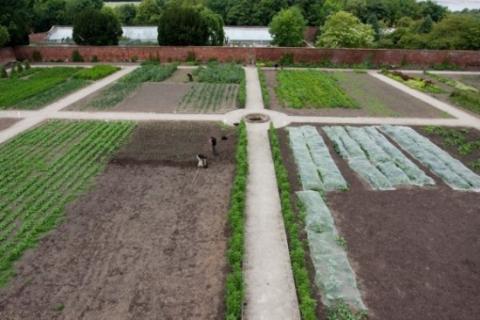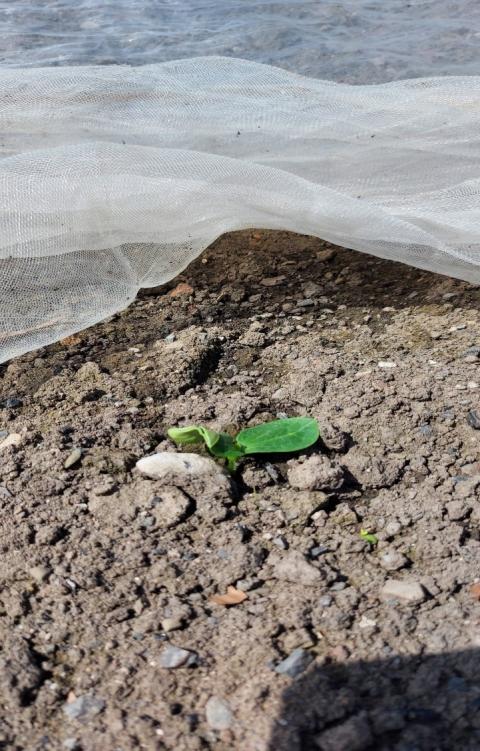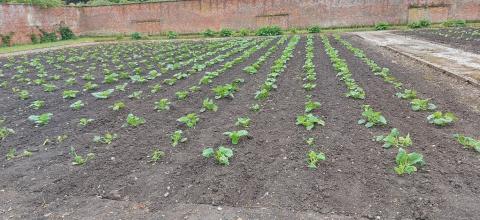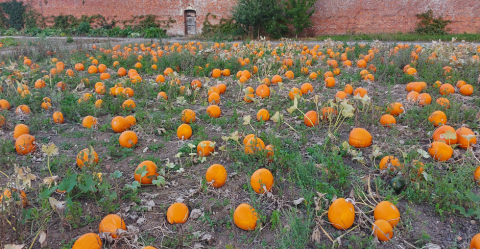Mostyn Kitchen Garden Final Report: Developing a Pick Your Own Pumpkin Enterprise
Introduction
Mostyn Kitchen Garden (MKG) is a Victorian walled garden set in the grounds of Mostyn Hall in Flintshire. There is a large orchard, and the 2.5 acres (1 ha) are used to grow a wide range of fruit and vegetables, including berries, rhubarb, tomatoes, beetroot, beans, herbs and salad crops. With a focus on generating added value, most of the produce is frozen at harvest, and made into jams and chutneys for sale locally throughout the year.
Traditional lean-to glasshouses are available, plus a range of horticultural equipment to allow self-contained production – including a propagator for modules.
With available growing area to consider a new crop and to provide further opportunity for public engagement, pumpkins were selected as a crop suitable for Pick Your Own (PYO). The site is an attractive place to visit, and is easily accessible from the A55 dual carriageway. There are also no farms in the immediate area producing a PYO pumpkin crop.
Study implementation
With increasing public demand for local outdoor experiences (which has intensified over the lockdown period), developing a PYO enterprise is an ideal way to tap into this market. Growing pumpkins for Halloween can potentially be a very lucrative source of income, but requires careful management to achieve production and clearance of the crop to meet a given short harvest window. On the plus side, pumpkins can be easily managed alongside routine growing activities, and require limited additional labour input.
Adding an additional visitor-based experience helps build business resilience. PYO can be a lucrative option, since it can attract both tourists and the local community, helping to establish links with the growing of food and supporting local farming and horticultural businesses. Pumpkins can also potentially offer a high-value return from the PYO market.
Project aims
The main objectives were to:
- Build knowledge on a suitable pumpkin growing plan to meet PYO requirements
- Explore how to provide the best visitor experience on a new PYO site
- Record the financial performance of this enterprise
Focus areas:
- Choice of pumpkin varieties, considering colour and size requirements
- Comparing growing from seed under cover with direct planting outdoors
- Optimum planting density
- Providing the correct nutrient balance
- Weed control
- Recording any disease issues (especially Blossom End Rot and powdery mildew)
- Determining whether irrigation was required
What was done
Pumpkins are a crop that requires little additional fertiliser or irrigation once established; excessive nitrogen usage will only produce more leaf at the expense of flowers and fruits. Soil testing showed that phosphorus and potassium levels were good, requiring only some maintenance low-level feeding for sustaining crop growth.
The planting area chosen followed a green manure crop of Phacelia, which was sown to capture residual soil nutrients over winter. When spring conditions permitted, the remains of the Phacelia crop were cut down by strimming and incorporated by ploughing. The ground was prepared for planting by spring and chain harrowing, and a small area was rotovated to form a seedbed where some seed was directly sown.
There was sufficient time to use a stale seedbed technique to reduce weeds during the last three weeks prior to planting. Flame weeding killed any germinating weeds, and regular hoeing dealt with weed control during the growing season.
Seeds were sourced from commercial companies, and varieties were selected to provide a wide choice to interest the public. The most popular pumpkins are large orange types, but medium and smaller ones are popular with younger children. Unusual types, such as white fruited, warty skinnned and small squash types also sell well, and can be planted fairly randomly to create a spectacle.
An area of approximately 2000m2 was selected for planting, with a spacing of 90cm x 90cm indicating a requirement for 2500 plants. This is approximately 0.5 acres (0.2ha).
Allowing for losses during germination and propagation, 2800 seeds were sown in modules under cover during week 20 (from 10 May) and germinated at 18C. They were grown on until they showed two true leaves (around week 23). This meant that they could be planted out during the last week of May when the risk of frost should have passed. A smaller quantity of seed was directly sown at the same time and fleeced for protection, to allow a comparison between direct drilling and planting out.
Direct-drilled germination June 2021
Planting and drilling were carried out by hand. Early weed control was done using a spring harrow and subsequently by hand-hoeing. The crop did receive some watering to get it started.
The supposition was that if 2500 plants were planted, and every plant produced one pumpkin with a 75% success rate, there would potentially be 1860 pumpkins to sell.
Established non-direct drilled plants end June 2021
Results
The crop established and grew well under cover, despite it being a poor spring, with April, May and early June being unseasonally cold. The module plants were of good quality and there were few losses. In the direct-drill trial, the pumpkins did not germinate as well as in the modules, which left gaps on the ground. In addition, the outdoor-sown plants that did survive and produce a crop gave poorer results compared to the plants grown under cover.
Weeds were kept under good control using the stale seed bed approach, followed by a combination of tractor-mounted scuffles and hand hoeing. The secret of hand weed control is to destroy the weeds when small. These within-row cultivations are also beneficial for letting air into the soil and helping to aid water penetration.
Springtine weeding, June 2021
The crop performed well, and by late July had covered the ground, inhibiting late weeds. Some powdery mildew appeared in August, but by then the crop was setting well. Controlling the mildew was discussed, but was not implemented, as access for spraying would have caused potential damage to the young setting fruits. In addition, mildew can be a help in a vigorous crop to let some light in, which helps to ripen the fruits, and this was the case in this instance.
With the area of 150 seeds sown direct, the plants looked more vigorous but produced a poorer-looking crop. In this instance, planting out module plants was found to be more successful, with fewer losses than direct-sown. Total pumpkins on the site were approximately 2500, but after losses for rot and pest damage, it was estimated that there were around 2000 pumpkins for sale.
Established pumpkin crop September 2021
A social media campaign was commenced a month before Halloween, and together with the estate name, proved enough to attract the public, with the crop sold out over six days of being open. In retrospect, there was not enough crop to satisfy the market demand, but the enterprise had made the most of all spare ground at the site.
Some pop-up catering (including cakes, refreshments and a local pizza van), plus access to the site’s value-added range of jams, chutneys, sauces, and vinegars, also proved popular, and offered opportunity to advertise preserves as Christmas gifts. There is a lot of scope to provide further additional activities, such as pumpkin carving, which add to the experience and serve to increase visitor spend.
Crop costings
Seed costs: 5000 seeds £250-£300 for an F1 hybrid.
Labour: Hand planting and weeding £1250 per ha.
Assuming 7500 marketable pumpkins per hectare at a PYO price average of £4, gross output of £30,000 per ha production means cost outlays are relatively small.
Conclusions
The crop was manageable with the existing staff and resources at the site, and was established and grown easily. Sowing under cover and planting out provided a better and more consistent crop than direct sowing into the ground. Weeds and mildews were successfully controlled by non chemical means.
Thanks to forward planning and targeted social media campaigns, the crop sold out very quickly. PYO and engagement with the public for this crop demonstrated that the public are eager to engage with growers of local produce, and farm tourism can be a viable alternative to mainstream edible production (which has become more difficult in view of the low prices achieved on fresh produce in more conventional markets). The PYO offering has also introduced new customers to the site and the range of added value products produced there.
The area of land devoted to the enterprise at 0.2ha would represent the minimum required for a viable outcome and a much larger area would make greater financial sense. Accordingly, the parking area would need to be increased, which could create problems with parking on grass if there was inclement weather. On the plus side, there would also be greater opportunity to make more income from charging a booking or entry fee per car on top of pumpkin sales on the day, as well as offering further catering and entertainment options.
The public response did encourage the garden to consider offering some PYO soft fruits and flowers in 2022 as these are difficult to harvest with the existing team so the exercise was useful.





